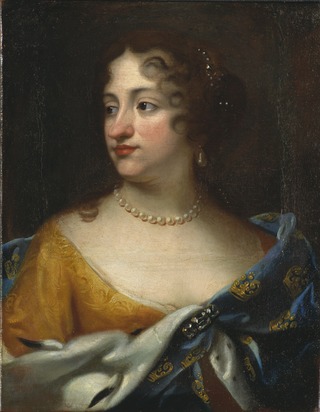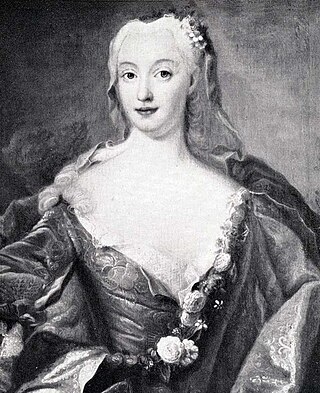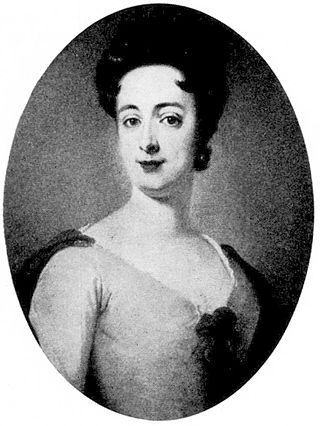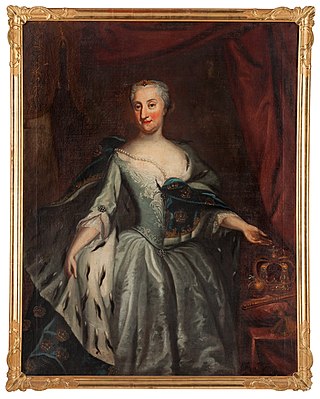
Ulrika Eleonora or Ulrica Eleanor, known as Ulrika Eleonora the Younger, was Queen of Sweden, reigning in her own right from 5 December 1718 until her abdication on 29 February 1720 in favour of her husband King Frederick, and then as his consort until her death.

The monarchy of Sweden is centred on the monarchical head of state of Sweden, by law a constitutional and hereditary monarchy with a parliamentary system. There have been kings in what now is the Kingdom of Sweden for more than a millennium. Originally an elective monarchy, it became a hereditary monarchy in the 16th century during the reign of Gustav Vasa, though virtually all monarchs before that belonged to a limited and small number of political families which are considered to be the royal dynasties of Sweden.

Riksdag of the Estates was the name used for the Estates of Sweden when they were assembled. Until its dissolution in 1866, the institution was the highest authority in Sweden next to the King. It was a Diet made up of the Four Estates, which historically were the lines of division in Swedish society:

The Council of the Realm, or simply The Council, was a cabinet of medieval origin, consisting of magnates which advised, and at times co-ruled with, the King of Sweden.

The Instrument of Government of 1634 was a document describing the form and operation of the Swedish government, retrospectively regarded as the country's first constitution, although it was not intended to function as such. It was composed by the Lord High Chancellor, Axel Oxenstierna, and was adopted by the Riksdag of the Estates on 29 July 1634. It was rendered void when the Riksdag repudiated it in 1680.

Ulrika Eleonora of Denmark was Queen of Sweden as the wife of King Charles XI. She is often admired for her generosity and charity.

Hedvig Ulrika Taube, also Countess von Hessenstein, was a Swedish courtier and countess, a countess of the Holy Roman Empire, and royal mistress to king Frederick I of Sweden from 1731 to 1744. She is regarded as one of only two official royal mistresses in Swedish history.

Hedvig Sophia Augusta of Sweden, Duchess of Holstein-Gottorp, was the eldest child of Charles XI of Sweden and Ulrike Eleonore of Denmark. She was heir presumptive to the Swedish throne from her birth until that of her brother one year later and again from the start of his reign as King of Sweden, in 1697, until her death and the regent of the duchy of Holstein-Gottorp for her minor son from 1702 to 1708. Some sources refer to her as Sofia.

The 1772 Instrument of Government was the constitution of the Kingdom of Sweden from 1772 to 1809. It was promulgated in the wake of the Revolution of 1772, a self-coup mounted by King Gustav III, and replaced the 1720 Instrument of Government, which had been in force for most of the Age of Liberty (1719-72). Although in theory the 1772 Instrument merely readjusted the balance of power between the Crown and the Riksdag of the Estates, without changing Sweden's status as a constitutional monarchy, in practice it is generally seen as instituting an absolute monarchy, especially after its modification in 1789 by the Union and Security Act, which further strengthened royal power at the expense of the Riksdag. It remained in force throughout the Gustavian era, until replaced by the 1809 Instrument of Government as a result of the Coup of 1809.

Charles Frederick, Duke of Schleswig-Holstein-Gottorp was a Prince of Sweden and Duke of Schleswig-Holstein-Gottorp and an important member of European royalty. His dynasty, the Dukes of Schleswig-Holstein-Gottorp, were a cadet branch of the ancient House of Oldenburg, which at that time was ruling Denmark-Norway. His mother was a sister of Charles XII of Sweden. Charles Frederick married a daughter of Peter the Great and became the father of the future Peter III of Russia. As such, he is the progenitor of the Russian imperial house of Holstein-Gottorp-Romanov and the patrilineal ancestor of all Russian emperors starting with Peter III, except for Catherine II.

Hedwig Eleonora of Holstein-Gottorp was Queen of Sweden from 1654 until 1660 as the wife of King Charles X Gustav. She served as regent during the minority of her son, King Charles XI, from 1660 until 1672, and during the minority of her grandson, King Charles XII, in 1697. She also represented Charles XII during his absence in the Great Northern War from 1700 until the regency of her granddaughter Ulrika Eleonora in 1713. Hedwig Eleonora was described as a dominant personality, and was regarded as the de facto first lady of the royal court for 61 years, from 1654 until her death.

Countess Catherine Opalińska, was by birth member of House of Opaliński, Queen consort of the Polish–Lithuanian Commonwealth twice and Duchess consort of Lorraine through her marriage with Stanisław I of Poland.
Instrument of Government was the constitution of the Commonwealth of England.

Emerentia von Düben also called Menza, was a Swedish lady-in-waiting, the favourite of Ulrika Eleonora, Queen of Sweden. She was known for her influence over Ulrika Eleonora.

The Swedish Empire was the period in Swedish history spanning much of the 17th and early 18th centuries during which Sweden became a European great power that exercised territorial control over much of the Baltic region. The beginning of the period is usually taken as the reign of Gustavus Adolphus, who ascended the throne in 1611, and its end as the loss of territories in 1721 following the Great Northern War.
Anna Woynarowska, was a Ukrainian noble. She was one of the greatest and most powerful of the private creditors of Charles XII of Sweden during the Great Northern War, and her claim on the Swedish state dragged on for years after the end of the war. In Sweden, she became known simply as "The Polish Countess".

Events from the year 1719 in Sweden

Events from the year 1713 in Sweden

Events from the year 1660 in Sweden

The 1720 Instrument of Government adopted on 2 May 1720 by the Riksdag of the Estates, was the constitution of the Kingdom of Sweden from 1720 to 1772, and was thus in force for almost the entirety of the period of constitutional monarchy known as the Age of Liberty, having replaced the largely identical Instrument of Government (1719).


















